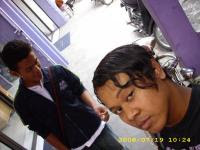
Tebet, a cluster residential area east of South Jakarta, might not have Bandung’s cool climate nor its elegant art deco buildings, but it does have its young and energetic personality.
Welcome to Jakarta’s own little Bandung!. Anissa S. Febrina explains more:
The secondary streets on the east and west sides of the area are jammed with cafes and boutiques.
“Endorse”, “nanonine house”, “deJons burger”, read the signs on a corner of Tebet where the waiters and shop assistants are often years ahead of their customers in the fashion stakes.
Other areas of Jakarta might be every bit as “out there”, but they lack the Paris-van-Java feel of Tebet and its distros (distribution stores).
The concept of (supposedly) alternative clothing stores took off in Bandung well before making it to the capital city.
“If you want to be one of a kind, you shop at distribution stores. No one else will be wearing the things you buy here,” said college student Nabila Djanti, who was working her way through a rack of tight T-shirts at a Tebet distro last week.
Besides the distros, young people spend most of their free time in the cafes — which are unbeatable see-and-be-seen spots and give them the chance to try out catwalk looks in real life.
During the day, the dress code is school uniform as students often drop by after classes. But at night, especially on weekends, teenagers get the opportunity to strut their stuff — including the retro shirts and frocks they bought at the nearby distros.
It was not until a couple of years ago that the commercial strips of Tebet were given a new lease on life. It started when the popular crowd and the arty kids felt that driving all the way to hang-out hubs in other parts of South Jakarta was all too much effort.
“The area’s market (for burgers) has been very good. There are a lot of college students and young workers in the area,” said
Daniel, the owner of a burger booth on Jl. Tebet Barat Dalam.
It is probably true that urban sprawl has created a market opportunity for those “in the know” about Indonesians’ great love of eating, hanging out and shopping.
But, then again, Tebet offers more than that.
Previously a forest-like area, Tebet’s population grew when residents of Senayan, South Jakarta, were relocated to the area in 1959 to make way for the development of a sports complex.
Old houses in Tebet represent the style of architecture typical of mass settlements of the 1960s with “pop out” window boxes.
No one knows for certain how the area got its name, but one thing is for sure, population-wise it is a rich heterogeneous settlement.
There is the established Tebet Barat where a lot of houses have been turned into offices or used as other commercial premises.
In contrast, there is also the more kampong-like Tebet Timur and Manggarai Selatan.
If the “little Bandung” part of the area represents established businesses, unique vendors in the kampong-like area add color and liveliness to Tebet.
If you’re feeling adventurous, you might like to go on a motorcycle taxi tour of the area. Chances are the driver will head directly to Suke: a fresh milk stall owned by Abdullah that has been there since 1965.
Next would be the famous street-side food stall Warmo, where some say you can find Jakarta’s best cheap eats.
Though known more for its food and fashion than for art, Tebet is also home to artist-run space “ruangrupa“, which circumvents the structures of private and public art galleries.
“We decided to base ourselves here because it’s a strategic location. But it is also true that Tebet has a strong creative aura,” said ruangrupa member Ardi Yunanto.
Another thing that sets Tebet apart is residents’ enthusiasm over its ongoing commercialization.
“We have to admit that living here is like living in an entirely different city. You can easily find any kind of food and other daily needs because of the new shops and restaurants,” said Wiwiek Suwignyo, who has lived in Tebet Timur for 30 years.
Tebet’s organic and unplanned development has made it a vibrant and alive area, unlike Jakarta’s sterile planned-from-scratch satellite cities.

Tidak ada komentar:
Posting Komentar